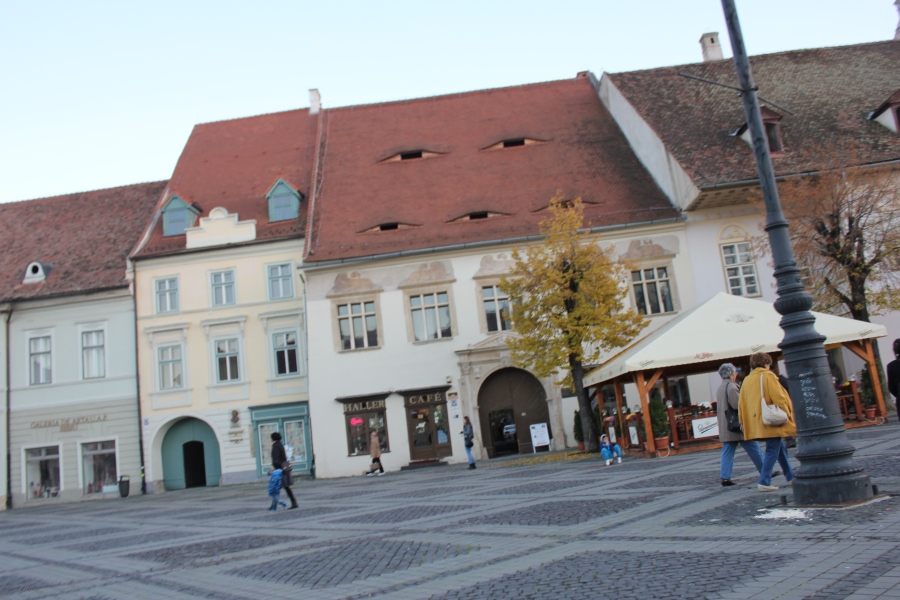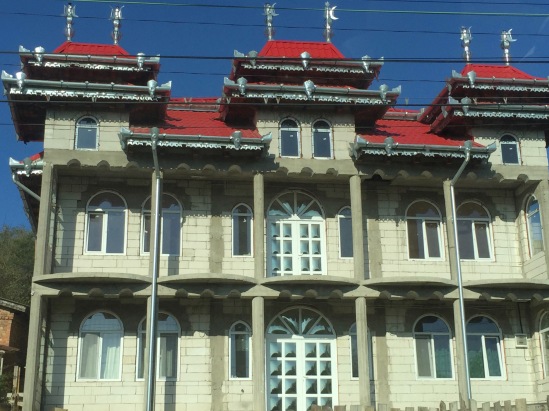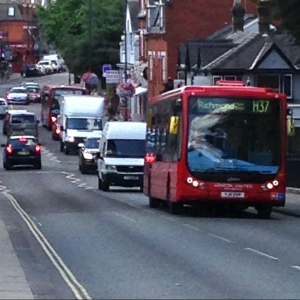Transylvania. The very name conjures a cinematic mash-up of monster iconography: deep black forests, spiky medieval lairs. Even seasoned travellers are apt to ask if it’s a real place. It is – this region of Romania extends from Brasov in the east to Cluj Napoca in the north, and almost as far west as Hungary. It comes by its horror-genre affiliations honestly. Transylvanian village Sighisoara was the birthplace of Vlad the Impaler (the “real” Dracula), and the entire region boasts enough Gothic-style medieval castles to stoke any Stoker fan. The imposing cliffs of the Carpathian mountains add to the mystique, soaring hundreds of meters high, a natural fortress surrounding the man-made ones.
But as we found on a trip to Transylvania last Halloween (because what better time to visit than a holiday that celebrates the region’s most famous inhabitants?), the real Transylvania is more mysterious than macabre. It’s an alt-universe hovering between past and present, Armageddon and Utopia. And since Romania made the list of Rough Guides’ Top 10 Countries to Visit in 2016 – citing its colourful medieval cities and Carpathian mountains – the time to go is now. We never saw a vampire, but we were properly spooked, and met with many unexpected discoveries. Here, just a few:
1. The Past, Perfectly Preserved. This is a territory whose boundaries have been contested, violated, drawn and redrawn for centuries. In many respects, modernity seems to be the only thing that hasn’t made a play for it. The Saxon heritage of the region is almost perfectly preserved in 13th-century “citadels” that populate the landscape. Sibiu, in Transylvania’s heart, is one such place: nestled in a mountain valley, the town is a visual vignette right out of the Brothers Grimm, with cobbled alleys and courtyards and rings of pastel-colored, steeply-roofed buildings slitted with vaguely sinister eye-hole windows.

As if the architecture weren’t enough to transport visitors several hundred years back in time, the appearance of a Romanian woman in colorful headscarf, fetching water from an ancient stone well in the center of town – or her husband, at the helm of a horse-drawn cart plodding through the fields – might. This is a place where cheeses and jams are sold in makeshift stands by the roadside; where women weave rugs in water-powered mills from the 19th century, and where horse-drawn carts vie with Dacias for space on dirt roads. It’s like a set from a period piece, but this is no authentic re-creation. It’s all real.

2. The Undead Language. Listen to its inhabitants speak, and read their signs. Romanian terms like “casa” (house) and “salut” (hello), phraseology more akin to Romance languages than to the Slavic tongues of Romania’s neighbors, compel unaware tourists (OK, me) to ask about a Spanish or Italian influence in this corner of Europe. One discovers quickly, though, that Romanian might well be the last remaining vestige of Latin itself: it is thought to be a continuation of the military language spoken in the Northeastern frontier region of the Roman Empire. The ghost of a language, on the breath of the living.

3. Heaven Amidst the Unholy. It’s not just the land of the ungodly. Sambata de Sus, in the Fagaras Mountains, has been home to the Brancoveanu Monastery since the 17th century, though Habsburg soldiers destroyed the original buildings in 1785 when the Orthodox monks refused to renounce their faith to Catholicism. Rebuilt in the 20th century, its braided columns, domed roofs and rounded archways – a blend of Byzantine, Ottoman, Renaissance and Baroque architecture – provide a space that is quietly mysterious in its holy devotion. This is a place to hear yourself think; it can be a bit disquieting for those who prefer the hustle-bustle of secular life.
4. Modern Ruins scarier than Dracula’s Castle. The brutal dictatorship of Nicolae Ceausescu from 1967-1989, and Communism’s fall, ravaged Romania’s industrial economy: Transylvania’s charming rural pictorials often yield to swathes of dystopian landscape. Hunedoara, home to the magnificently creepy, 14th-century Corvin Castle, is proof that a vampire fortress can be significantly more inviting than its modern surroundings. The town once boasted 86,000 inhabitants and the largest steel works in Romania; today, just a tiny fraction of the town’s industry still operates, making for a panorama of abandoned buildings that are oddly beautiful in their crumbling decrepitude. From the dark hollows of Corvin Castle’s windowed turrets, where Vlad the Impaler is rumoured to have been imprisoned, one can peer out across the valley and spy vertical black mazes of smokestacks and pipes rising up in uneven silhouettes against the sky, an ominous visual made all the more so by the complete absence of sound.
A ramshackle old municipal building looks out on a car park, empty save for an elderly man in a frayed lawn chair and some stray dogs. Quiet, Eastern-bloc housing complexes loom above courtyards for which human activity appears to be only a memory. Many of the villages, too, show signs of abandonment: a hollowed-out Post Office here, with shattered glass like jagged teeth in the windows; an abandoned firehouse there, a peer inside revealing the shadowy forms of deserted hoses and ladders.

It feels, in many ways, like the aftermath of some kind of cataclysm, from which the Romanian people still struggle to recover. Poverty is pervasive, and begging is not uncommon anywhere in Transylvania, despite its relative affluence. At a gas stop, travelers are approached by a man holding a sleeping baby across his chest. The baby’s head lolling to one side, its appearance of deep unconsciousness, induces the group to procure bills and coins from their pockets at once, despite the protestations of local tour guides who’ve already warned against this sort of thing. Sometimes it is children who do the asking, and a little girl with a small bouquet of wilted flowers tries to pawn off her stems to dinner guests at a restaurant. She is bustled out by impatient waitstaff, and onlookers watch as she darts across the busy street, disappearing into an alleyway. She can’t be more than five or six years old, but her parents are nowhere to be seen. It is a frightening contrast: old-world agrarian contentment in a region that still struggles to feed itself.
5. Mysterious Mansions. Beyond Hunedoara is a road lined with “gypsy mansions,” so called by the inhabitants themselves. The mansions are symbols of success for the country’s wealthiest Roma – a traditionally nomadic people whose thousand-year diaspora spread them across the globe. Here in Romania, Roma comprise 3.3% of the population, but retain an insular culture that’s largely a mystery to outsiders. Don’t meander, we are told: the local inhabitants are fiercely protective of their neighborhood, and resent outsiders’ suspicions about how the wealth was accrued to build such monuments. Gaze instead upwards, at the colossal, multi-story structures, their Pagoda-esque tin roofs blazing in the sunlight. Painted vivid reds and creamy yellows, they are a bold splash against the dusty landscape, a shining antidote to the colorless post-industry decay of Hunedoara.

6. Ferocious inhuman locals covered in fur. Away from the towns and villages of Transylvania lie the imposing slopes of the Carpathian Mountains, some of the most unspoiled and undeveloped terrain in Europe. A steep ascent into the woods – led by a camouflaged Romanian smoking a cigarette and hauling a giant sack of maize – brings tourists to a cabin on stilts. Inside, through a large plate-glass window, they watch the guide pour maize into hollowed logs below. And the spectacle of bear watching begins: the massive creatures lumber into the hide from the surrounding woods, draping themselves over logs, snuffing out hidden bounty from the hollows within. They wrestle and play. When they abruptly stop eating and rise up, in unison, on their hind legs, it’s hair-raising for the humans, too. This collective sensed danger: the drone of a large logging truck, trundling by.

In the end, it was Transylvania’s future that haunted us the most. Was the logging truck an indication that the “land between the forests” would disappear, along with the brown bears? Will Transylvania become as overdeveloped and modernized as the West, its frozen-in-time quality dissolving like a stream of water down a camera lens, wiped away and replaced with images that look like everything else?
Or, if the economy does improve, will desperate parents stop sending their little girls out to sell dead flowers to strangers? Will the sounds of industry ring out again in towns that have known nothing but silence for a quarter century?
Contemplation of this bitter tradeoff – damaging one habitat to save another – leads to a wish for Transylvania: that it not only retains its contrasts, but burnishes them to become its defining traits. Juxtapose the old with the new, the natural with the man-made, the creepy with the charming, in a way that benefits all its inhabitants – living and undead.











Wonderful – I’m gonna try to post it on Expedia. (Your British spelling is noted.)
LikeLike
Thanks for being a fan, Mom!! I tell everyone that 10% of my followers are my mother. 🙂 Love you!
LikeLike